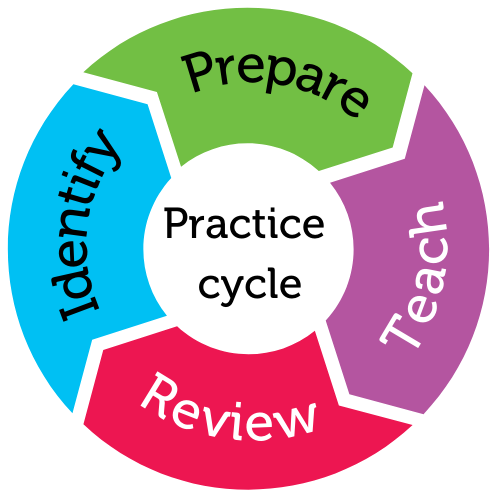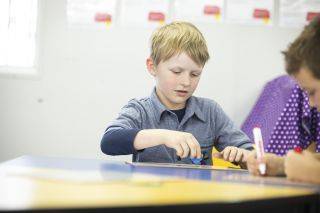
For student year
Helps students to
- stay motivated
- remain on-task for longer
- feel valued
Helps teachers to
- facilitate learning
- regularly check behaviour
- identify concerns
Summary
Instructional feedback is an encouraging response that you give students directly in relation to their on-task performance, learning or behaviour.
In this practice, you will read about why feedback is important and will revisit how to make it:
- meaningful
- motivating and
- constructive.
How this practice works
Watch the video to learn more about this practice.
Duration: 3:42
Australian Professional Standards for Teachers related to this practice
4.1 - support student participation
5.2 - provide feedback to students on their learning
For further information, see Australian Professional Standards for Teachers AITSL page
Preparing to teach
The value of feedback
Appropriate and timely feedback has a positive impact on students':
- attitude
- engagement
- motivation
- behaviour
- learning
- sense of achievement.
Effective feedback provides the student with information on:
- where they are going (their goal)
- how they are going
- where to go next.
The feedback you give your student should be meaningful, timely and communicated effectively. Quality feedback is completely objective. As Wiggins (1998) states, "Feedback is not about praise or blame, approval or disapproval. That’s what evaluation is – placing value. Feedback is value-neutral. It describes what you did and did not do.”
Types of feedback
Descriptive encouraging
Descriptive encouraging is a process of describing exactly what you can see or hear from a student that you hope to see more frequently, thereby highlighting their competence and abilities. This can sound like, "I can hear most people using their inside voice for group work" or "I like that you keep asking questions when you're unsure to clarify your understanding." By acknowledging positive student behaviours, you provide feedback that the behaviour is desired and increase the likelihood of it occurring again.
Instructional
Instructional feedback focuses on a cycle of cue, student action, and teacher feedback. The teacher provides a cue for learning or behaviour (e.g., "When we do group work we use soft voices"), followed by a student action, and then teacher feedback in response (e.g., "Let's soften those voices just a bit more so we don't disturb others"). Instructional feedback may curb challenging behaviours and increase learner engagement.
Remember
- Know and take into account the abilities, characteristics, and preferences of each student. This will make your feedback personalised and positive.
- Identify one aspect of the task or behaviour that the student has done well, and one that could be done better or differently.
- Pair feedback with a reinforcer such as a high-five, handshake, personal message or token.
- Feedback can also be non-verbal - from a simple thumbs up to using a visual reward chart.
Before you start
- Reflect on and review your instructional and feedback procedures, together with communication/interaction styles, to see what you would like to focus on.
- Develop and plan responsive and flexible feedback procedures appropriate to each lesson/topic that
- is more frequent
- provides highly specific guidance
- provides specific feedback
- provides specific rewards.
- Consider if you would like to set up a token economy. A token economy is a system designed to reinforce desirable behaviour and learning. Tokens are small rewards that can be used to motivate students during less-preferred tasks and activities.
Prior to the lesson choose, prepare and implement supporting visual resources such as
- positively worded classroom rules
- cumulative reward systems
- written instructional sequence/lesson plan formats
It works better if:
- Visual supports such as positive behaviour rules, cumulative reward systems schedules, and lesson plans are in place and used as reference points for guidance and feedback.
- You focus on specific outcomes and expectation.
- You give feedback that is non-evaluative, immediate, enthusiastic, and varied.
- You accompany it with highly motivating reinforcers/rewards.
It doesn’t work if:
- There are no visual behaviour rules or visual learning supports in place.
- Learning-based behaviour expectations are inconsistent.
- Feedback is not linked to the immediate task.
- Feedback focuses only on errors, offers no solutions, is negative or unvaried.
- Reward systems are unmotivating or are used to deduct points/rewards previously earned.
In the classroom
Step 1. At the start
Refer to the supporting visual resources.
Make the intended learning clear and explicit. Remember it might be:
- performance
- learning
- behaviour
Proactively and explicitly explain the behaviour expectations with reference to visual rules. For example, “It's quiet time for today’s reading” or “Our number work today is a partner time activity so soft voices are OK”.
Use tokens during less-preferred tasks and activities.
Step 2. During
Consistently refer to the visual instructional sequence/ lesson plan throughout the activity.
Actively monitor student progress during the activity.
Observe for examples of good performance, learning or behaviour and provide students with positive and varied feedback that is immediate and logically linked to the task or behaviour you hope to see.
When you observe examples of performance, learning, or behaviour which could be improved, provide descriptive encouraging to set the student back on the right track. Provide positive suggestions for improvement in terms of task expectations or learning-based behaviour. Scaffold task performance if necessary.
Positively review and summarise students’ performance, emphasising successes, suggesting improvements for next time, and allocating motivating rewards via the visual system.
How will I know if it’s working?
- The frequency of the appropriate on-task behaviour increases over time.
- Student can demonstrate learned skills in response to feedback.
- Student will display more confidence in their abilities.
Practice toolkit
Practice implementation planner template
We know it's not always easy to keep track of what's working and what isn't. So, we've created this template for you to record and reflect on what you're doing to create more inclusive classrooms. The implementation planner contains:
- guidance around goal setting
- a reflection section (what worked, didn’t work, what to change, and next steps)
- prompting questions.
Implementation planner with examples
Set your professional learning goal for:
Provide feedback on learning & behaviour
Benefits of goal setting
Setting, working towards, and reflecting on goals helps you grow professionally and improve your practice. You can access AITSL learning resources for teachers to learn more about:How to set goals
The Australian Institute for Teaching and School Leadership recommends using the SMART matrix to frame your goal setting.SMART goals refers to goals that are:
- Specific
- Measurable
- Achievable
- Relevant
- Time-phased
Resources
Example visual support: Expected behaviours
Example visual support: Unexpected behaviours
Example visual support: Volume
Provide feedback on learning & behaviour - Practice Brief
Related Practices

Interact with every student
TEACHING PRACTICE
For student years
Helps students to
- feel valued
- engage in interactions
This practice is from the core research project
Learning Cycle

